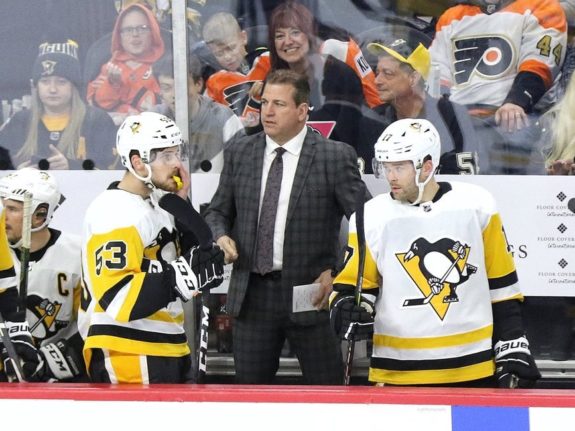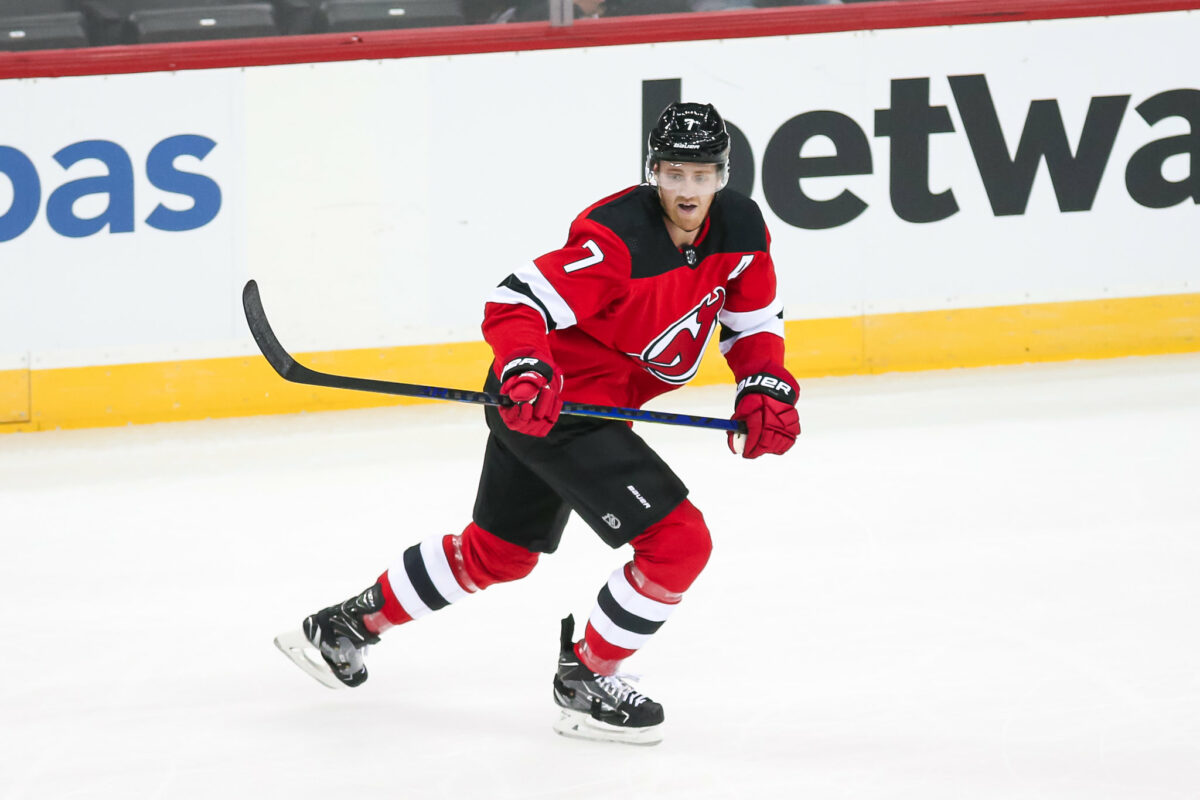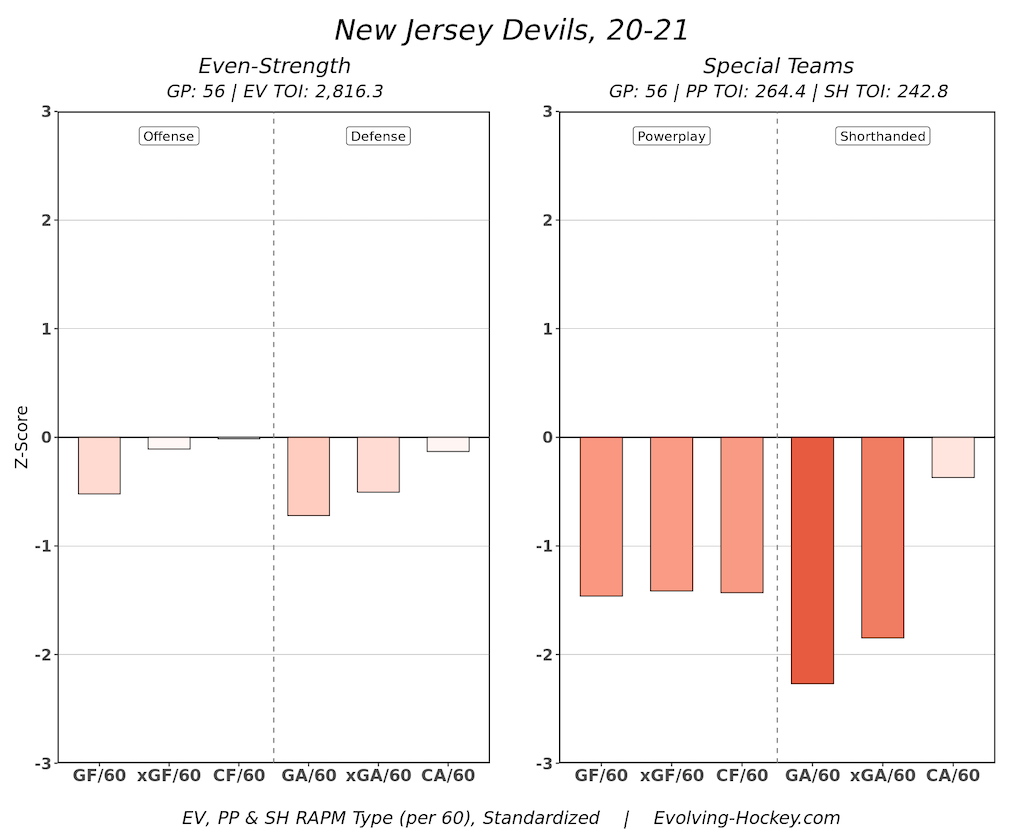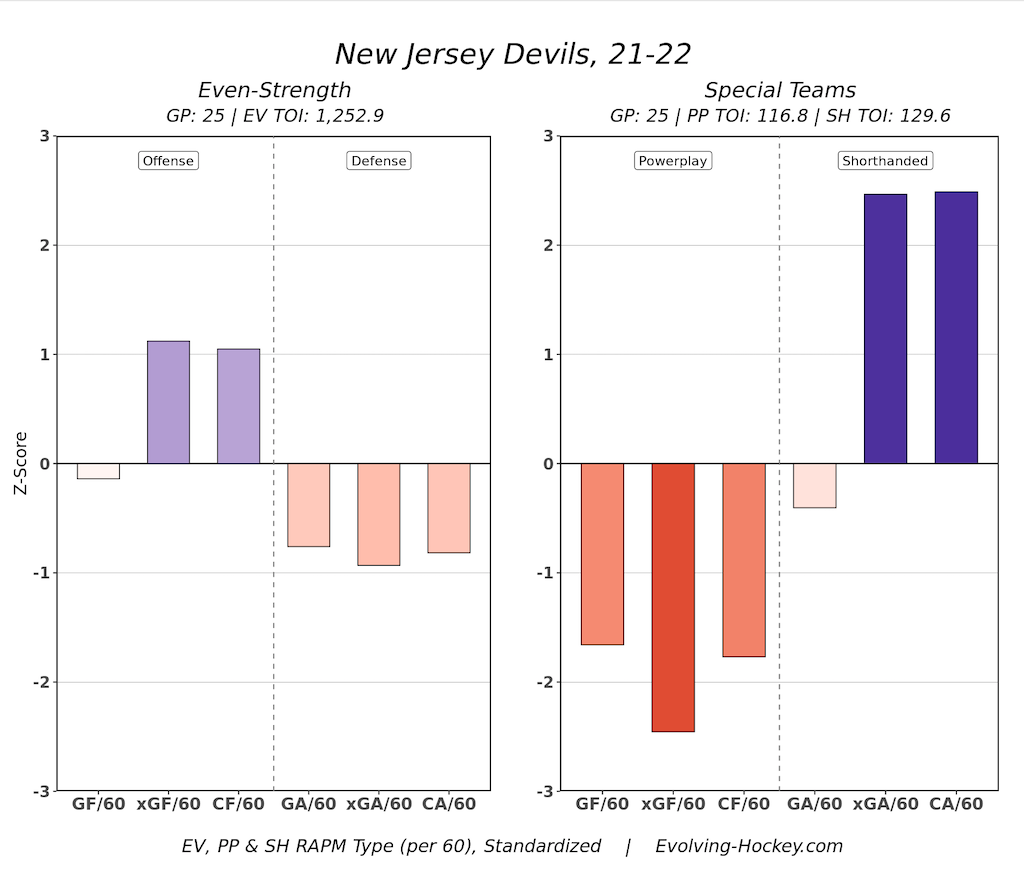With a record of 10-11-5, it’s hard to argue that the New Jersey Devils have improved from where they were a season ago. But it’s true; they are better than they were in 2020-21. Unfortunately, there’s one thing that’s completely wiping out any progress they’ve made. And once again, it happens to be their power play, which has been that much of a net-negative on their results.
Power-play struggles are nothing new for the Devils. It was a problem last season and continues to be a significant one in 2021-22. Coming into tonight’s tilt against the Philadelphia Flyers, the Devils’ power play ranks 31st in the league, with a conversion rate of 12.68 percent. Only the Arizona Coyotes have a worse power play, and the Coyotes are not exactly going for it all this season. Let’s look at what’s wrong and why the Devils have to get their power play in order quickly if they want any chance of reaching their goal of playing meaningful games in March and April.
Devils’ Year-Long Power-Play Struggles
Before getting into what’s wrong with the Devils’ power play this season, it’s worth going over its struggles from 2020-21. Context is important. The Devils hired Mark Recchi as an assistant coach, hoping he’d help resurrect a power play that had struggled for a few seasons. But so far, the opposite has happened.
In Recchi’s first season in 2020-21, the Devils converted on 14.9 percent of their power plays and had some of the worst shot and chance per 60 minutes rates in the league. They averaged 78.79 shot attempts per 60 minutes and 5.15 expected goals per 60 minutes (xGF/60). Both of those ranked in the bottom five of the NHL.
Another issue that plagued the Devils was the lack of puck movement on the power play. They were too stationary and couldn’t create shooting lanes with royal road passes (cross-ice seam passes). When the puck movement isn’t there to throw penalty killers off balance, it’s hard to pull off royal road passes, too. Penalty killers can get their sticks in passing lanes without much problem.

Moving ahead to the 2021-22 season, and many of those issues are still prevalent. The Devils still rank in the bottom five in shot attempts per 60 minutes and xGF/60. Their shot quality has even dipped, as their xGF/60 now sits at 4.44. What’s worse is their power-play goal differential has also dropped. In 2020-21, the Devils scored 20 power-play goals while giving up four shorthanded goals. They’ve only scored eight power-play goals this season and have already given up four shorthanded goals. That’s a goals for percentage (GF%) of 66.67 percent, the worst in the league and by more than 10 percent.
The Devils’ power play has been particularly bad as of late too. It’s six for its last 58, and when you factor in shorthanded goals given up, it’s a net of two for 58. That’s a net conversion rate of 3.4 percent, which would be a historically terrible power play. It’s hard to win games consistently when your power play only converts on 12 percent of its chances. It’s virtually impossible when its net conversion rate is 3.4 percent. If we scale down the sample size to the Devils’ last 12 games, and they’ve actually been outscored 3-2 in 30 power-play opportunities — a net success rate of -3.3 percent.
Related: 3 Takeaways From Devils’ 3-2 Loss to the Predators
It’s not like the Devils lack talent, either. Jesper Bratt is on pace for 75 points, and Andreas Johnsson is having a career season. Dougie Hamilton was one of the best power-play quarterbacks in the league before signing as a free agent this offseason, but his numbers have dropped significantly. That’s not a personnel problem; that’s a system problem. And it’s killing the good the Devils have done elsewhere.
Devils Improving Almost Everywhere but the Power Play
The Devils had a 19-30-7 record in 2020-21 and struggled in many areas. They were a middle-of-the-pack team at five-on-five — their Corsi for pecentage (CF%) of 50.5 percent ranked 13th, while their expected goals percentage (xG%) of 49.02 ranked 18th. But what submarined them was poor special teams and goaltending. So far, in 2021-22, they’ve seen improvement with the penalty kill and goaltending, though less so in net, and even at five-on-five.
Through 26 games, the Devils’ CF% of 51.56 percent ranks 10th in the league at five-on-five, while their xG% of 50.1 percent ranks 14th. Their penalty kill gave up the second-most expected goals per 60 minutes in 2020-21 and only killed off 70.95 percent of opponents’ power plays. This season, their penalty kill has a success rate of 79.52 percent, and only the Carolina Hurricanes are suppressing shot attempts and expected goals at a better rate on the penalty kill than the Devils.

While team goaltending hasn’t improved much, Mackenzie Blackwood has been a bit better, sporting a save percentage (SV%) of .911, up from .902 a season ago. And his goals saved above expected (GSAx) is about zero, a big improvement from GSAx of just above -12 that he posted in 2020-21. They’re going to need him to be better than a .911 goaltender, especially since it seems Jonathan Bernier could be out long-term with an injury, but for now, they’ll take it.
That brings us back to the power play. Though most of the Devils’ improvements this season have been moderate, it’s still been enough where they should have a better record than 10-11-5. To visualize the difference from 2020-21 to 2021-22, let’s take a look at the team’s regularized adjusted plus-minus (RAPM) from Evolving-Hockey to see the difference between even-strength offense and defense, the power play, and the penalty kill:
Notice that while the power play had a net-negative impact last season, it’s been even worse in 2021-22. The Devils’ even-strength defense hasn’t been great, but it’s not killing them like their power play is. Meanwhile, their penalty kill has taken a complete 180 for the better. Whether they can get positive results with Bernier absent remains to be seen, but it’s been quite a bit better.
If the Devils had just a league-average power play (20.12 percent), they could possibly have somewhere around three to five more wins. Instead of being 10-11-5, they could be 13-11-5 with 31 points. Or maybe they’d be 14-8-4 with three more regulation wins and one less overtime loss with 32 points instead of the 25 points they have now. That’s not an insignificant difference.
Related: Devils’ Power Play Struggles Are Nothing New
Would the Devils be an NHL powerhouse with a better power play? Probably not. But having 31-32 points would put them only one to two points behind the Pittsburgh Penguins for fourth place in the Metropolitan Division with three more head-to-head matchups. They want to be playing meaningful games in March and April, and being that close to the Penguins in the standings would keep them within reach of that goal.
It’s Simple: Fix the Power Play
There’s really no complicated plan for how the Devils can get their season back on track. Fix the power play. It’s that easy. The problem with their power play being such a net-negative is it’s leaving no margin for error at other game states. The penalty kill has to be flawless. They can’t afford defensive mistakes at five-on-five, goaltending has to be above average to elite, and they have to get all their scoring at five-on-five.
That’s not a recipe for success. Not even close. If the Devils fix their power play, they’ll get more favorable results. If it’s going to remain this way until the final buzzer sounds on the 2021-22 season, then it’ll be another year of the Devils not playing meaningful games in March and April. That’ll lead to another lost season when that never should’ve never been the case.
* * *
Advanced stats from Natural Stat Trick


